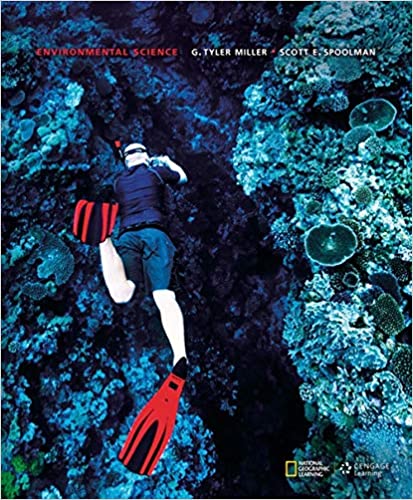
Environmental Science 15th Edition by Scott Spoolman,Tyler Miller
Edition 15ISBN: 978-1305090446
Environmental Science 15th Edition by Scott Spoolman,Tyler Miller
Edition 15ISBN: 978-1305090446 Exercise 17
WHY DO CALIFORNIA'S SOUTHERN SEA OTTERS FACE AN UNCERTAIN FUTURE?
The population size of southern sea otters ( Core Case Study ) has fluctuated in response to changes in environmental conditions. One such change has been a rise in populations of the orcas (killer whales) that feed on them. Scientists hypothesize that orcas began feeding more on southern sea otters when populations of their normal prey, sea lions and seals, began declining. Also, between 2010 and 2012, the number of southern sea otters killed or injured by sharks increased for reasons that scientists are trying to understand.
Another factor may be parasites known to breed in the intestines of cats. Scientists hypothesize that some southern sea otters might be dying because coastal area cat owners flush feces-laden cat litter down their toilets or dump it in storm drains that empty into coastal waters. The feces contain parasites that then infect the otters.
Otters are also threatened by blooms of toxic algae that are fed by urea, a key ingredient in fertilizer that washes into coastal waters. Other pollutants released by human activities are PCBs and other fat-soluble toxic chemicals that can kill otters by accumulating to high levels in the tissues of the shellfish on which otters feed. Because southern sea otters feed at high trophic levels and live close to the shore, they are vulnerable to these and other pollutants in coastal waters.
The factors listed here, mostly resulting from human activities, plus a fairly low reproductive rate and a rising mortality rate, have hindered the ability of the endangered southern sea otter to rebuild its population (Figure 5.B). In 2012, the National Geographic Society funded a project led by Nicole Thometz to learn more about why juvenile sea otters, in particular, were suffering a high mortality rate. The aim of this study was to track changes in the physiological development of the otters and to understand how physiological variables affected their foraging ability and success. Such information could be used to help biologists to refine recovery plans for the southern sea otter. According to the U.S. Geological Survey, the California southern sea otter population would have to reach at least 3,090 animals for 3 years in a row before it could be considered for removal from the endangered species list.
Critical Thinking
How would you design a controlled experiment to test the hypothesis that cat litter flushed down toilets might be killing southern sea otters?

FIGURE 5.B Changes in the population size of southern sea otters off the coast of the U.S. state of California, 1983-2013.
Compiled by the authors using data from U.S. Geological Survey.
The population size of southern sea otters ( Core Case Study ) has fluctuated in response to changes in environmental conditions. One such change has been a rise in populations of the orcas (killer whales) that feed on them. Scientists hypothesize that orcas began feeding more on southern sea otters when populations of their normal prey, sea lions and seals, began declining. Also, between 2010 and 2012, the number of southern sea otters killed or injured by sharks increased for reasons that scientists are trying to understand.
Another factor may be parasites known to breed in the intestines of cats. Scientists hypothesize that some southern sea otters might be dying because coastal area cat owners flush feces-laden cat litter down their toilets or dump it in storm drains that empty into coastal waters. The feces contain parasites that then infect the otters.
Otters are also threatened by blooms of toxic algae that are fed by urea, a key ingredient in fertilizer that washes into coastal waters. Other pollutants released by human activities are PCBs and other fat-soluble toxic chemicals that can kill otters by accumulating to high levels in the tissues of the shellfish on which otters feed. Because southern sea otters feed at high trophic levels and live close to the shore, they are vulnerable to these and other pollutants in coastal waters.
The factors listed here, mostly resulting from human activities, plus a fairly low reproductive rate and a rising mortality rate, have hindered the ability of the endangered southern sea otter to rebuild its population (Figure 5.B). In 2012, the National Geographic Society funded a project led by Nicole Thometz to learn more about why juvenile sea otters, in particular, were suffering a high mortality rate. The aim of this study was to track changes in the physiological development of the otters and to understand how physiological variables affected their foraging ability and success. Such information could be used to help biologists to refine recovery plans for the southern sea otter. According to the U.S. Geological Survey, the California southern sea otter population would have to reach at least 3,090 animals for 3 years in a row before it could be considered for removal from the endangered species list.
Critical Thinking
How would you design a controlled experiment to test the hypothesis that cat litter flushed down toilets might be killing southern sea otters?

FIGURE 5.B Changes in the population size of southern sea otters off the coast of the U.S. state of California, 1983-2013.
Compiled by the authors using data from U.S. Geological Survey.
Explanation

This question doesn’t have an expert verified answer yet, let Examlex AI Copilot help.
Environmental Science 15th Edition by Scott Spoolman,Tyler Miller
Why don’t you like this exercise?
Other Minimum 8 character and maximum 255 character
Character 255


